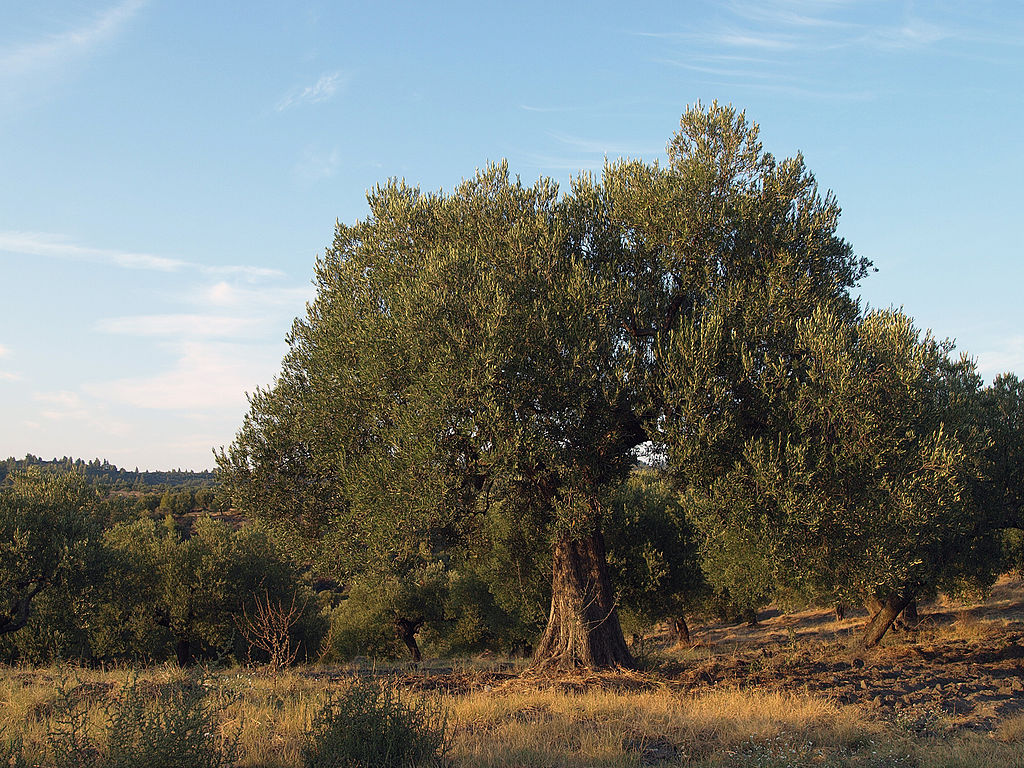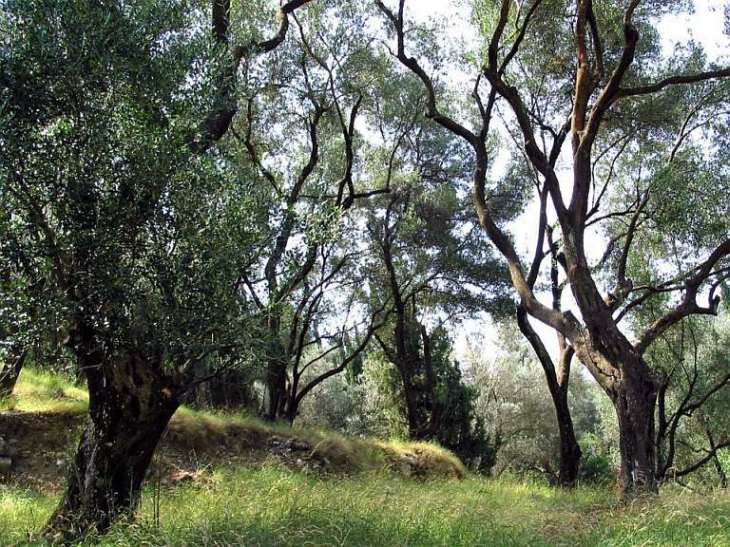.

Olive tree, Sithonia, Greece: photo by Edal Anton Lefterov, 5 September 2009
I...Monsanto Man on Tractor, 9 AM
Out walking,
Out walking,
Smelling something faintly
Evil in the air
And not knowing exactly where
It’s coming from,
We finally come across a man
At a crossroads somewhere
Among the myriad olive trees
And ask him where he’s been
Spraying since daybreak to find out
Just where we can proceed safely,
Only to have him shoot back with a
No problem, folks. I’ve just finished.
You can walk anywhere.

Olive tree near Karystos, Eboiea, Greece: photo by Tim Bekaert, 20 March 2005

Olive trees (Olea europaea ssp. europaea), Corfu, Greece: photo by Cezanne, 16 July 2003

Monsanto phosphorus plant, Soda Springs, Caribou County, southeast Idaho. This phosphate ore-processing plant was originally constructed by the Morrison-Knudsen Company in 1950, and production started in 1952. As of 2011, P4 Production LLC (Monsanto’s wholly owned subsidiary) owns the phosphate mining and processing facilities. The phosphate ore processed at Soda Springs comes from nearby (10–20 miles away) phosphate deposits laid down in Permian-era oceans ca. 250 million years ago. In the plant’s furnaces elemental phosphorus is refined from phosphate ore. Phosphorus is used as an important ingredient of Roundup brand herbicides and for some other products: photo by akasped, 10 September 2010
II...Tree House

Greece's wealth on the bough: photo by Vassilis Zambaras, 2007
“Houses, you know, grow stubborn easily, when you strip them bare.”
-- George Seferis, from Thrush
Not your usual idea
Of a child’s elevated playhouse
Full of youthful abandon,
Full of youthful abandon,
But this
Abandoned, low-lying roofless
Abandoned, low-lying roofless
Shell of decaying stone walls
Inhabited by stubborn runaway
Brambles and wild olive trees
Rooted firmly to the earth.
Rooted firmly to the earth.

The "face" of an ancient olive tree: photo by Vassilis Zambaras, 2007
“If you haven’t built a house, dug a well, and married off a son or daughter, you haven’t lived.” -- Greek proverb
As part of her dowry, Eleni was given about a hundred olive trees in a grove in the middle of nowhere about 9 kilometers due west of Meligalas; the only way you could get there in 1981 was to park your car a kilometer away and go on foot uphill for about 20 minutes. Every winter, my mother-in-law and her late husband would walk down from Revmatia to this olive grove during olive harvesting time (a two-and-a-half- hour walk) with a donkey ladened with provisions, all six children, the goats and anywhere from 15 to 20 sheep. Once there, they would stay in a tiny 3x3 sq.m stone hut for as long as it took them to harvest the olives-- usually a week, but longer if it was a good year. In 1981, Eleni and I decided to tear down the hut, together with the nearby sheep enclosure and use the stones to have a new house built in the grove, but first we had to find enough cornerstones for its construction; using our Fiat 127, we immediately set out rummaging through the countless heaps of dumped stones and piles of rubble scattered all over Messenias to find the pieces we needed.
For this small 4 x 6 sq.m house, we only required about 50 cornerstones and fortunately for us but not for traditional Greek village architecture, at this time people were still demolishing traditional stone houses in fits of modernist frenzy and building new monstrosities out of reinforced concrete and brick and calling it “progress,” so it was fairly easy finding cornerstones. And that’s just what Eleni and I did in the ten years between the building of the little house in the grove and the construction in 1991 of the much, much larger two-storey stone residence our family now lives in. By then we had amassed approximately 1,200 cornerstones—more than enough for the house and the stone wall in front—and were known throughout Upper Messenias as that “somewhat batty couple in a battered Fiat 127 who were gathering, of all things, cornerstones.” [NB: It might interest readers to know that cornerstones from old demolished houses are now selling at 30 € a piece and up.]
But back to the grove. During Fall, Winter and Spring and when the two children were still too young for school, we would leave Meligalas every other Friday night after I had finished with my English lessons, drive the car (filled with enough food and other provisions to last us until Monday morning) to where the dirt road morphed into a rut, and then haul the kids and provisions up to the house—no electricity, no phone, no running water, no other people, owls hooting, jackals crying at night, millions of stars—for a weekend in Paradise. As strange as it might seem, when we came back down to idyllic Meligalas on Monday, it felt as if we were returning to Hell aka Civilization.
Vassilis Zambaras: from One Down (Twice), Two to Go, from Vazambam, Saturday 11 July 2011

Ancient olive tree in Pelion, Greece: photo by Dennis Koutou, 30 January 2011

Bird Hunters sign, outside Monsanto phosphorus plant, Soda Springs, Caribou County, southeast Idaho. This phosphate ore-processing plant was originally constructed by the Morrison-Knudsen Company in 1950, and production started in 1952. As of 2011, P4 Production LLC (Monsanto’s wholly owned subsidiary) owns the phosphate mining and processing facilities. The phosphate ore processed at Soda Springs comes from nearby (10–20 miles away) phosphate deposits laid down in Permian-era oceans ca. 250 million years ago. In the plant’s furnaces elemental phosphorus is refined from phosphate ore. Phosphorus is used as an important ingredient of Roundup brand herbicides and for some other products: photo by akasped, 10 September 2010

Olive trees on Thassos, Greece: photo by Peter Pakandl, 7 September 2006
Allen Upward: Athene's Tree
That old Talk about the Gods, which is called mythology, is confused in many ways, partly because all language is confused, partly because it is a layer of many languages. When the talkers no longer used the beast as an idol, they used it as a symbol, in short a word; when they no longer slew the real christ at Easter, they named the sun at Easter, Christ. Their language is tangled and twisted beyond our power wholly to unravel, because it was beyond their power; because it began as a tangle, when man's mind was still a blur, and he saw men as trees walking, and trees as men standing still.
How hard the old cloistered scholarship, to which the Nobels of a bygone age gave their endowments, has toiled to understand the word glaukopis, given to the goddess Athene. Did it mean blue-eyed, or gray-eyed, or by the aid of Sanskrit merely glare-eyed? And all the time they had not only the word glaux staring them in the face, as the Athenian name for owl, but they had the owl itself cut at the foot of every statue of Athene, and stamped on every coin of Athens, to tell them that she was the owl-eyed goddess, the lightning that blinks like an owl. For what is characteristic of the owl's eyes is not that they glare, but that they suddenly leave off glaring, like lighthouses whose light is shut off. We may see the shutter of the lightning in that mask that overhangs Athene's brow, and hear its click in the word glaukos. And the leafage of the olive, whose writhen trunk bears, as it were, the lightning's brand, does not glare, but glitters, the pale under face of the leaves alternating with the dark upper face, and so the olive is Athene's tree, and is called glaukos. Why need we carry owls to Oxford?-- Allen Upward: from The New Word (London, 1908)
Vassilis Zambaras: Monsanto Man on Tractor, 9 AM (from Vazambam, 19 October 2011); Tree House (from Vazambam, Wednesday 2 February 2011)



8 comments:
Tom,
Lovely photos of olive trees in Greece, making a place for Vassilis' two poems and story of building a house up there in the grove (finding those cornerstones!). Maybe I've driven by that Monsanto plant in Idaho -- was as strange and sinister in person as in these photos. . . .
12.28
pink edge of grey cloud above blackness
of ridge, song sparrow calling in field
in foreground, sound of wave in channel
was seen then, seemed to go
almost out as if lost
scene, condition, was often
exposed to whole plot
orange edge of sun rising out of cloud,
shadowed green pine on tip of sandspit
Interesting--owls, I was recently told, are considered bad luck by the Native Americans. I don't know if that is true? But my mother loved them and always talked about gray-eyed Athene. I suppose that is the translation we are used to . . .
There are so many owls in the woods here, and sometimes in spring, they dive-bomb runners.
And Monsanto is so evil, and so connected with every level of government here, all the way up to the Supreme Ct..
But of course you know that.
I sometimes think it's all too depressing to think about.
Nice shade under those trees.
The Butterfly
The fur on your wings makes you a lion
beating, testing the thin air. All
the flowers
in the field are men and you go to
each one, tasting.
The men flowers sing their song
about pollen.
Their eyes are red and their guts
are white marble (phosphorous)
from the inside of mountains.
Pulled out from the middle of the
hills.
Now you are lifting the skirts
of women and birds and flowers
underneath the leaves of the aspens
(olives).
Green drunken curses. The sheep
(goats) graze so quickly.
Tom Clark has just "done a number" on me but I'm not mad--I just want to thank him for taking the time to organize such a good job!
(Which boils down to every poet should be so lucky as to have such a careful and generous reader.)
Vassilis is to be thanked for his generosity and tolerance of the xenoi.
The little owl, Athene noctua, has a life beyond the daytime world.
Allen Upward's profound work echoes in The Cantos of E. Pound, a poem of owlish vision.
Canto 20:
the olives... the leaves green and then not green... the click of light in their branches
Canto 74:
... in stone is no imprint and the grey walls of no era / under the olives / saeculorum Athenae / γλαύξ, γλανκώπις, / olivi / that which gleams and then does not gleam / as the leaf turns in the air
The global nightwork of the chemical deathcorp that invades Vassilis's olive grove is, as Nin suggests, and as Stephen may have witnessed, at least as ubiquitous as it is notorious. The literature here is as endless as the victims are helpless.
Monsanto's Harvest of Fear (Vanity Fair, May 2008).
Speaking of which...
Nin's mom must have been a shamaness in an earlier existence.
To an Apache, dreaming of an Owl signified approaching death.
"...the Apaches view the owl as the most feared of all creatures (Opler 1965). In 1997, a spokesperson for the Apache [described] the deep taboo against owls. Historically, Apaches shared the widespread Athabascan fears of owls as the embodied spirit of Apache dead. John Bourke, in his 'Apache Campaign in the Sierra Madre,' related a famous story of how Apache scouts tracking Geronimo became terrified when one of the U.S. soldiers found and brought along a Great Horned Owl. The scouts told Bourke that it was a bird of ill omen and that they could not hope to capture the Chiricahua renegades if they took the bird with them. The soldier had to leave the owl behind (Bourke 1958)."
Over time and across space however the lore grows complicated.
Cherokee women of the Carolinas once bathed their children's eyes in water containing owl feathers, reckoning it would help them stay awake. A Cherokee story explains why owls are nocturnal:
"When the animals and plants were first made -- we do not know by whom -- they were told to watch and keep awake for seven nights, just as young men now fast and keep awake when they pray to their medicine. They tried to do this, and nearly all were awake through the first night, but the next night several dropped off to sleep, and the third night others were asleep, and then others, until on the seventh night, of all the animals only the owl, the panther and one or two more were still awake. To these were given the power to see and to go about in the dark, and to make prey of the birds and animals which must sleep at night."
Cherokee shamans value Eastern Screech-Owls as consultants, because owls are thought to have the ability bring on sickness as punishment.
The Hopi view the Burrowing Owl as their god of the dead, the guardian of fires and tender of all underground things, including seed germination.
But can it really be true that Burrowing Owl insists growing things must be killed before they emerge from the ground?
The Hopi name for Burrowing Owl is Ko'ko, which means "Watcher of the dark".
The Little Burrowing Owl, aka Athene noctua minor, has a life beyond the daytime world, and sees things day folk do not see.
Hopi also believe that the Great Horned Owl helps their Peaches grow. But then... here come the herbicide sprayers.
The Inuit believe that the Short-eared Owl was once a young girl who was magically transformed into an Owl with a beautiful long beak. But the Owl got really scared and flew into the side of a house, flattening its face and beak.
The Kwakiutl see Owls as souls of wandering lost people, not to be harmed, for when an Owl is killed the person to whom the soul belonged will also die.
The Menominee people believe that day and night were created after a talking contest between a Saw-whet Owl (Totoba) and a rabbit (Wabus). The rabbit won and selected daylight, but allowed night-time as a concession to the vanquished Owl.
To the Mojave people of Arizona, one would become an Owl after death, this being an interim stage before becoming a water beetle, and ultimately pure air.
In the Sierras, native peoples believe the Great Horned Owl captures the souls of the dead and carries them to the underworld, where they become Genetically Modified.
Some but not all of these inklings concerning Athene noctua come out in the wash in Little Hymn to Athene.
Some but not all of these inklings concerning Owl inhabit the shadows of The Spell.
Thanks to Ed Baker for backchanneling his "take... on that Inuit-Owl Beautiful Girl w Long Beak."
Looking good, Edster.
Also, do forgive my indulgence in word origins, Allen Upward and Vassilis have made me do it.
Maybe this is obvious, but...
Glaucous (from the Latin glaucus, meaning "bluish-grey or green", from the Greek glaukos) -- "olivi / that which gleams and then does not gleam / as the leaf turns in the air..." -- is a term used to describe the pale grey or bluish-green appearance of the surfaces of some plants, such as the olive tree, as well as in the names of birds, such as the Glaucous Gull -- a good example is the beauteous bird at the bottom of Virgil's Vigil.
Another day for the birds, then.
And we have Mr Zambaras the Poet to thank for it all.
Post a Comment